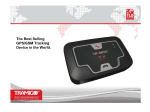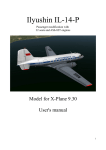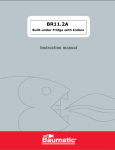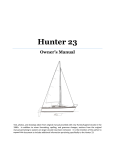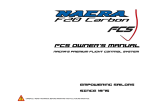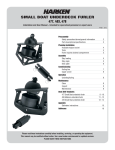Download Owners Manual - Dynamic Flight Hang Gliding School
Transcript
Dynamic Flight School 17 Tansey Court, Trawalla, Victoria, 3373 Phone / Fax : 03 5349 2845 Email : [email protected] Web : www.dynamicflight.com.au Hang Gliding Harness Owners Manual Skorpion II RR Harness by Dynamic Flight Congratulations on your purchase of the Skorpion II RR Harness by Dynamic Flight. Your harness has been constructed from the finest materials available and should reward you with years of reliable service. As with all your flying equipment, periodic maintenance and adjustment will be required. Please take the time to read this manual and familiarise yourself with your new harness before taking your first flight. Contents 1. 2. 3. 4. 5. 6. 7. 8. Description of design Warning and disclaimer Using your new harness for the first time Usage instructions Packing your harness Emergency procedures Maintenance and care Periodic inspection schedule 1. Description of design The Skorpion II RR is designed to offer the lowest drag possible in a hang gliding harness by allowing the pilot to point directly into the airflow more often. Additionally the Skorpion II has been complimented with a variety of innovations that are likely to be copied by other harness manufactures shortly. The Skorpion II RR features include: Single airfoil riser. Enclosed slider. Internal zip-up & down ropes. Alloy back plate for unequalled comfort, low profile and smooth lines. Hands-free Pilot Attitude Adjustment System. Twenty ‘G’ main and back up harness up to carabiner. Tapered boot to eliminate drag area behind feet. Neoprene shoulder and neck fairing to minimise frontal disturbance. The Skorpion II RR is a contemporary front entry design representing years of development work. A single main airfoil riser is attached to an enclosed single stainless steel shaft that allows movement of the harness centre of gravity (CoG) which accommodates the differing requirements for take off/landing and prone flight. The use of a single airfoil riser reduces the drag associated with other riser systems. For take off and landing the slider assumes a forward position which places the suspension point in front of the pilots CoG. This enables an excellent head up position to be effortlessly maintained. Inside the harness are two spectra lines which connect the slider to the boot. With the main riser fully forward the boot is compressed and pulled out of the way of the pilots legs. This allows long take off steps and ensures trouble free landings. After take off the pilot places their feet in the boot and extends their legs. This action extends the boot so that the spectra lines pull the main riser into the rearward position, behind the pilots CoG. With the main riser in this rearward position the pilot easily rotates to a prone position. The degree of head up/down is adjustable in flight by the pilot stretching his body lengthwise from heel to right shoulder, which un-cleats the rope. This shrugging of the shoulder is best combined with a few centimeters of pushing up to reduce tension on the rope, you will be rewarded with a click of the rope freeing from the cleat mounted on the alloy backplate. Without reducing length from shoulder to heel the pilot can set his/her angle of attack. As soon as pilot’s length is relaxed the rope will lock in the cleat. Sensitivity and length adjustment for pilot height can be made with the 25mm orange strap that comes out of the harness over the right shoulder. This adjustment should be made whilst in prone and is mandatory prior to flying the harness. This is easily done hanging from a beam with a chair for arm support. The harness is opened and closed using the zip lines, which are held, at convenient waist position on velcro tabs. When in the upright position the frontal zippers should be well open to allow the pilot long running steps for launch and landing, the webbing chassis secures the pilot when in this position. If you have chosen the Velcro Zip option, the zip is attached to the harness with velcro which allows the pilot to kick their legs free in the event of a zip failure/jamming. Full continuous webbing is used throughout to ensure that you remain safely suspended even if all the fabric used in constructing the harness was to fail. Mil spec skydiving buckles are used on the shoulder straps. Stubai 13kN (1300kg) breaking strain buckles secure the chest and waist webbing. A 4000kg+ breaking strain steel carabiner is supplied as standard. The frame is constructed of 5083-aluminium alloy. The slider is constructed of high quality stainless steel double sleeved tubing. The aluminium frame spreads the load along the pilot, maintaining comfort on those long flights whilst forming very smooth lines. 2. Warning and disclaimer Hang gliding is a high-risk sport. The safe operation of this harness ultimately rests with you – the pilot. This harness will require periodic inspection and maintenance as outlined in the maintenance schedule of this manual. Failure to adhere to the maintenance schedule may result in your harness failing to function as designed. The owner and operator must understand that due to the inherent risks involved in flying a hang glider no warranty of any kind is made or implied against accidents, bodily injury or death, other than those which cannot by law be excluded. 3. Using your new harness for the first time Before taking your first flight in your new harness it is essential to tune the hands-free pilot attitude adjustment system. We strongly recommended you become familiar with its operation whilst remaining safely on the ground. We suggest you hang your harness from a suitable point and practice using it. You should also become familiar with the operation of the zip up/down lines. You should also be able to get in and out of prone without difficulty. When transitioning from prone to hang you will notice a small clunk as the slider comes forward, this will be associated with the assumption of a head up position. In the head up position the front zipper should open to above the lower buckle to accommodate long steps for running. When transitioning from hang to prone you will notice that a little effort is required to extend your legs and pull the slider back. As it moves behind your CoG you will feel yourself rotate head down to horizontal. The zippers can then be completely closed if the pilot lifts a little weight off the zipper around the thighs and mid-section. The degree of head up/down is adjustable in flight by the pilot stretching his/her body lengthwise from heel to shoulder with a slight head-up motion to uncleat the adjustment rope. This movement will be associated with a click of the rope freeing from the cleat mounted on the alloy backplate. Head up can then be altered by the pilot applying pressure to the base-bar to lift the chest, relaxing the body length-wise then relaxing the arms will result in the rope cleating to hold that position. Equally, head down adjustment can be achieved by uncleating, lowering the chest to the desired height then relaxing the lengthwise tension to allow the rope to lock in the cleat. Optimal drag reduction is achieved with a five to ten degree head down from horizontal whilst on glide with the bar pulled in. Correct adjustment for pilot height/length can be carried out by tightening the orange 25mm velcro strap that comes out of the harness over the right shoulder. This trigger strap must be adjusted to be slightly firm when the shoulder pads are altered for the pilot height/length. Your harness has been custom made to fit you. It has been ‘tested flown’ with a dummy adjusted to your dimensions prior to leaving the factory. When in the harness, with the boot zipped up, the shoulder straps should be snug. They are adjusted by removing the webbing from the velcro tabs, sliding the webbing through the buckles and then replacing the webbing on the velcro tabs. The shoulder fairing and head up/down trigger strap must also be adjusted after this procedure and can be done using the velcro tags. This harness has been designed to balance after you mount the parachute in its container. You should follow the directions in the maintenance and care section. It is vital that you can reach the deployment handle and that pulling it releases your parachute. This must be tested before flight. It is also equally important that your parachute cannot accidentally deploy. If you are not familiar with parachute packing procedures we strongly recommend you enlist the help of a qualified rigger. 4. Usage instructions .1 Preflight your harness to per the preflight schedule. .2 Suspend your harness from glider’s hang loops with the carabiner and then lock the gate by turning the knurled knob. .3 Place your legs through the leg loops. .4 Clip together both sets of buckles, mind to flip the chest pad between the chest buckle and your chest. .5 Engage the upper central zipper and close it down to your navel. Do not force it. .6 Ensure all ropes are secured to their respective velcro tabs to prevent tripping over them or having them catching on objects such as tow dollies, ramps, etc. .7 Hang check. Ensure head up/down adjustment allows adequate clearance of the base tube. Double check your legs are through the leg loops and the Stubai buckles are closed. These checks are designed to ensure you do not fall out of your glider and will be comfortable in flight. History has shown that preflight checks are well worth the effort. Never skip them. .8 Squat down in the harness to bring the slider fully forward so the boot is pulled clear of the legs for the take off run. Take off as normal. .9 Once in stable flight place feet in boot, and extend legs while transferring hands to base tube to assume prone flight position. Remember to aviate, navigate then pronate. Numerous accidents have occurred to pilots who have neglected this rule while trying to get into prone. If you are new to prone flight we recommend the following guidelines. Firstly remember this is no hurry to go prone – you can happily soar in hang. Once the glider is safely airborne check you are flying at trim (aviate) and not on a collision course with anything (navigate). Only after you have established this should you search for the boot with your feet. We recommend you do this by feel as if you spend much time looking down for the boot you are unlikely to be either aviating or navigating. Once the boot is found slip your feet in but do not push out. Aviate and navigate. Next place one hand on the base tube. Extend the legs without pushing or pulling on the A frame. As you drop into prone transfer your other hand to the base tube. Aviate and navigate. Once settled in prone flight and clear of the ground and traffic close the harness zipper using the zip up line on your right. .10 5. Before landing you will need to extend your undercarriage and get into a head up position. This is easily done by unzipping with the tag on your left side. Slip your feet out of the harness and rock gently into the upright position for landing, the slider movement will be positive and easy to notice. Remember to locate the zipper tag back onto its velcro retainer to avoid tripping on the excess rope. Packing your harness Your harness has been designed to enable you to pack everything needed for cross-country flight. We recommend you use the following method. Lay your unzipped glider bag flat on the ground and fold it to the length and width of the storage area inside the back of the harness. Place wallet, keys, coins ect inside the harness bag, fold the harness bag into a long package and place it on top of the glider bag. Lay the harness on the ground, carabiner side down, and open the full-length internal pocket zip. Place your drinking bladder in the bladder pocket. Place the folded glider and harness bags along the full length of the internal bag. Arrange this gear for a relatively even thickness along the back of the harness. Roll tip bags and other padding bits to fit tightly into the shin storage areas.. Do up all the zips. The streamlined low profile side pocket has been designed to fair the arm on glide and hold a small camera or radio and gloves. All are easily accessible in flight. Avoid overloading this side pocket as it makes the harness difficult to zip up in flight The parachute fairing is an ideal place to store extra pack-up gear and can be accessed by slipping the hand under the neoprene over the chute container. The Skorpion II should be quite snug with all the pack-up gear inside. 6. Emergency procedures 6.1 Failure to hook in Your harness can only keep you suspended from your glider if you are correctly hooked into your glider. History has shown that this can be forgotten. In the usage instructions we recommend the procedure of always clipping your harness into your glider and then getting into the harness. We also strongly recommend a hang check as a double safety. If you do fail to hook in your options are to immediately release your glider and fall the (hopefully) short distance to the ground or to stay with the glider. Staying with the glider is likely to mean you are hanging from the base tube. In this position the glider will trim at quite a fast speed and possibly begin to oscillate. Your options are:- 1. to remain hanging on to the base tube if the landing is close at hand; 2. to release one hand and deploy your parachute; or 3. to try to climb into the A frame and either fly the glider in the A frame or try to hook in. You will not be able to hold on for very long and will require considerable strength to climb into the A frame so deploying a parachute may be the best option in many cases. Any need for this knowledge is removed by always doing a hang check before flight. 6.2 Failure to put your legs through the loops The leg loops prevent you from slipping out of the harness when in the hang position. If you do not put your legs through them you will find yourself hanging by your armpits. Do not raise your elbows too high or you may fall out. If you can get your feet into the boot you can prone out and zip the harness up to secure yourself. You should either land still zipped up or keep your feet in the boot of the harness all through your landing approach and final bringing them out at the last moment to ensure you do not fall out of your harness. 6.3 Failure of zip to do up This simply presents you with an inconvenience. You can prone out and fly around but will not be as comfortable or warm as usual. 6.4 Failure of zip to undo If you are unable to get the zip to undo you have two options. If you have sufficient height and time before landing you can use your fingers to separate the velcro (if you have chosen the velcro option). Your legs can then be used to separate the zip from the harness body allowing your legs to be extended so a normal landing can be achieved. If you do not have the velcro option you will have to land still zipped up. The softest landing can be achieved by sliding in whilst prone. Fly a normal final into the wind, rounding-out lower, bleed off excess speed with the harness just off the grass. The glider will slow down below normal stall speed due to ground effect. As the glider loses energy give a good flare. If you have wheels you will likely roll to a stop. If you do not have wheels you may well nose in when the base tube hits the ground. Airfoil speed bars can slide well on grass but keep your thumbs above the base tube prior to touch-down! Proper care and maintenance should prevent any problems with your zip. Don’t forget to tie up your shoelaces and secure any loose clothing which may jam the zip. 6.5 Free fall parachute deployment Your harness has been designed for hang gliding use and has ample strength in the unlikely event you need to deploy your parachute. You may have heard stories of pilots being sucked up into storm clouds and then jumping out of their gliders and deploying their parachutes when near the ground. Your harness should have adequate strength to survive the loading of a free fall opening but your parachute probably will not. Hang gliding parachutes are designed for lightweight, small size, and rapid deployment at low speed. These design features are in stark contrast to the design criteria of sky diving parachutes. The rapid deployment feature of our parachutes means they will generate extremely high (much higher than skydiving) loads if deployed at terminal velocity (-200kmh). We strongly recommend you exercise good judgement and do not place yourself in the situation where you are considering leaving your glider to parachute down. 7. Maintenance and care 7.1 General To keep your harness in good condition store it in its protective bag in a dry place out of direct sunlight when not in use. Never store your harness damp as moisture promotes the growth of mildew. If it gets damp air-dry it out of direct sunlight. If it gets very wet you may also need to remove, dry and repack your parachute. Ultraviolet light, some petroleum products and alkaline detergents all attack the materials your harness is made from and will weaken it – avoid these coming into contact with your harness. 7.2 Fitting a parachute If you have never stowed a parachute in a container it is strongly recommended you seek help before attempting this procedure – it is much easier seen done than described. First slide the parachute bridle insider the main riser. Use a piece of electrical wire to pull the bridle through the inside of the main riser. The hang loop vertical stitching is designed to separate upon deployment. Next slip the carabiner through the main, back-up (red) and parachute risers. Lay the bridle forward to the neoprene shoulder fairing, make sure the main riser is fully to the rear of the slider. Partly undo the velcro on shoulder fairing and push the bridle under the neoprene taking care to keep on the parachute side of the front rope. Ensure the bridle comes back out at the parachute container corner and then into the parachute container. Lay the bridle into the parachute container using an S-fold method. Do not stow the bridle with rubber bands. Place the deployment bag on top of the bridle in the parachute container. If required securely attach supplied deployment handle to the existing deployment bag handle. This is done by looping the supplied handle through the deployment bag handle then through itself. Close the container by passing the short bungie loops through the grommets in appropriate sequence, the last grommet is mounted in the fairing neoprene, then use the deployment handle rope to trap these loops, one on the outside of the container, the other under the flap. A packing string passed down through the grommets, starting from uppermost and working down to the bungie loop, then back up in reverse order will simplify this procedure by allowing the loops to be easily pulled up through the grommets. Once the container is closed check that the parachute is secure by vigorously applying a knee behind the container to see if it causes an accidental deployment. Ensure that sufficient bridle is free that the movement of the slider is not restricted. After fitting a parachute for the first time have a hang in the harness and ensure you can easily reach the deployment handle and that when you pull it your parachute comes out of the container. Failure to correctly pack your parachute into your harness may result in an inability to deploy your parachute when you need it, or the parachute may deploy accidentally. Both problems may result in serious injury or death. If unsure consult your dealer. 7.3 Cleaning procedure It is recommended that you do not use any detergents to clean your harness. Most detergents are alkaline and will weaken the harness structure. If you insist on using a detergent use only one that has been specially formulated for cleaning sailcloth. It is preferable to use only a damp cloth to wipe off any dirt and then allow your harness to air dry out of direct sunlight. Better still keep your harness clean in the first place. 7.4 Salt water immersion If you land in the ocean and manage to retrieve your harness you must follow the following steps to avoid serious damage to your harness and parachute. When salt water immersed fabric dries microscopic salt crystals are left behind. These act like miniature knives which cut the fibres of the harness webbing and fabric. The recommended procedure used by parachutists is to keep everything completely wet with salt or preferably fresh water. Do not let things dry out. Remove all removable metal items. Open all zips and pockets. The parachute will need to be removed from its container and deployment bag. The entire sodden mass is then placed in a garbage bin or bath tub and a series of fresh water flushes are applied – the more the better. Once all the salt has been rinsed out the material is air-dried out of direct sunlight. In testing decreases in strength of up to 50%+ have been reported following salt-water immersion and drying without rinsing. Correctly rinsed 90%+ of the original strength is retained. Never land in surf. 8. Periodic inspection schedule These guidelines are based on experience with the problems which can and do occur with harnesses. It is strongly recommended that you follow them to ensure your harness gives optimal service. Inspections are due after the stated number of flying hours or the elapsed period of time, whichever is the sooner. Preflight Check ropes are not tangled and make sure their ends are correctly located on their respective velcro tabs. Ensure internal zippers are closed, and boot zipper is fully undone. Check head up/down adjustment rope is cleated off so you will hang above the base tube when in prone. Check parachute container is securely closed. Check Stubai buckles and carabiner for positive locking function. Every 10 hours or 1 month Check zippers and sliders for smooth function and lubricate with silicon spray if necessary. Adjust boot-slider ropes if required (these may stretch in normal use). The slider ropes should be just tight when the boot is extended and the sliders are in their most rearward position. Every 50 hours or 6 months Check main risers for wear, these are easily replaceable. Check all stitching is secure. Check all ropes and webbing for wear. Check main body zip is in good condition. Check wear on head up/down cleat. Every 100 hours or 12 months Check main risers for wear and replace if necessary. Check all stitching is secured and repair as required. Check all ropes and webbing for wear and replace if necessary. Check main body zip for smooth function and replace if necessary. Check head up/down cleat for wear and replace if necessary. Inspect frame for wear. Inspect carabiner and all buckles for wear and positive spring and locking function. Every 200 hours or 2 years Replace main risers, main body zip, all ropes and head up/down cleat. Every 500 hours or 5 years Expected normal service life. Depending primarily on use and care your harness may last longer than this however it is recommended you return your harness to the manufacturer for full safety inspection and overhaul. If you detect problems during any inspection do not fly in the harness until these are satisfactorily corrected. Date of Manufacture ………………………………………………………………. Serial Number ………………………………………………………………. Made by ………………………………………………………………. Name Signature Final Inspection by ………………………………………………………………. Name Signature Safe flying and remember – it only gets better Dynamic Flight Team











